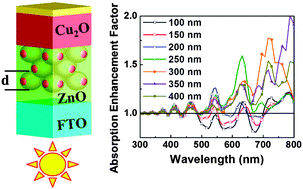Modulating light propagation in ZnO–Cu2O-inverse opal solar cells for enhanced photocurrents†
Abstract
The advantages of employing an interconnected periodic ZnO morphology, i.e. an inverse opal structure, in electrodeposited ZnO/Cu2O devices are presented. The solar cells are fabricated using low cost solution based methods such as spin coating and electrodeposition. The impact of inverse opal geometry, mainly the diameter and thickness, is scrutinized. By employing 3 layers of an inverse opal structure with a 300 nm pore diameter, higher short circuit photocurrents (∼84% improvement) are observed; however the open circuit voltages decrease with increasing interfacial area. Optical simulation using a finite difference time domain method shows that the inverse opal structure modulates light propagation within the devices such that more photons are absorbed close to the ZnO/Cu2O junction. This increases the collection probability resulting in improved short circuit currents.


 Please wait while we load your content...
Please wait while we load your content...